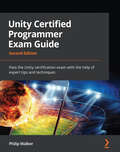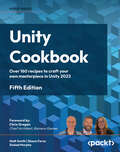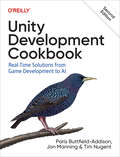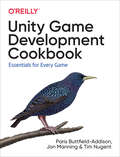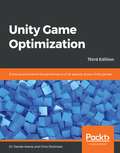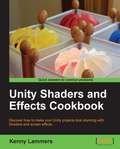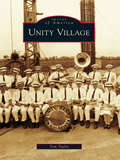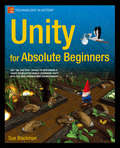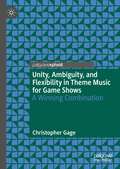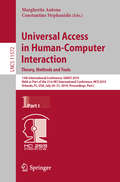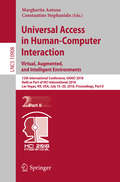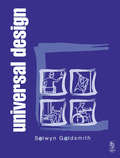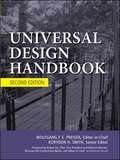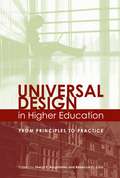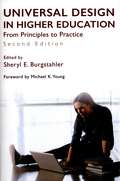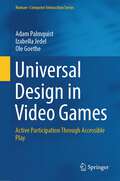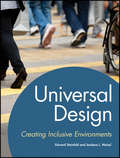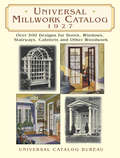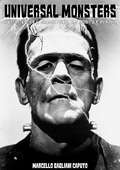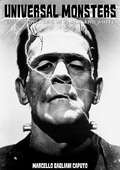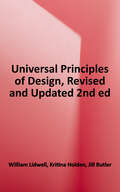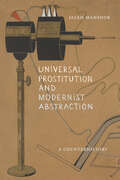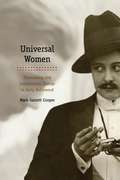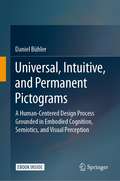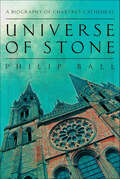- Table View
- List View
Unity Certified Programmer Exam Guide: Pass the Unity certification exam with the help of expert tips and techniques, 2nd Edition
by Philip WalkerA practical guide to Unity game scripting using C#, along with practice tests, exam tips, and easy-to-follow examples to help you pass the exam and become a professional Unity programmerKey FeaturesLearn essentials of game scripting with Unity and C# to customize aspects of your gameTackle challenges in Unity game development and the certification exam using effective techniques and solutionsPrepare for the latest Unity certification exam using mock tests, exam tips, and self-assessment questionsBook DescriptionUnity Certified Programmer is a global certification program by Unity for anyone looking to become a professional Unity developer. The official Unity programmer exam will not only validate your Unity knowledge and skills, but will also enable you to be a part of the Unity community. This study guide will start by building on your understanding of C# programming and taking you through the process of downloading and installing Unity. You'll understand how Unity works and get to grips with the Unity exam's core objectives. As you advance, you'll enhance your skills by creating an enjoyable side-scrolling shooter game that can be played within the Unity Editor or any modern Android mobile device. This Unity book will test your knowledge with self-assessment questions and help you take your skills to an advanced level by working with Unity tools such as the animator, particle effects, lighting, UI/UX, scriptable objects, and debugging. By the end of this book, you'll have developed a solid understanding of the different tools in Unity and be able to create impressive Unity applications by making the most of its toolset.What you will learnDiscover techniques for writing modular, readable, and reusable scripts in UnityImplement and configure objects, physics, controls, and movements for your game projectsUnderstand 2D and 3D animation and write scripts to interact and use Unity's rendering APIExplore Unity APIs for adding lighting, materials, and textures to your appsWrite Unity scripts for building interfaces for menu systems, UI navigation, application settings, and much moreFocus on SOLID principles for writing clean and maintainable Unity applicationsWho this book is forThis Unity engine book is for game developers, software developers, mobile app developers, and Unity developers who want to advance in their career and gain gaming industry certification. The book assumes basic knowledge of C# programming and the Unity engine.
Unity Cookbook: Over 160 recipes to craft your own masterpiece in Unity 2023
by Matt Smith Shaun Ferns Sinéad MurphyAre you ready to take your Unity game development skills to the next level? Look no further! The "Unity Cookbook 2023, 5th Edition" is your essential guide to mastering the latest features of Unity 2023, packed with over 140 recipes to empower your game development journey. Purchase of the print or Kindle book includes a free eBook in the PDF format.Key FeaturesExplore VR and AR development to create immersive experiences that redefine gamingCraft captivating mobile games with optimized performance and user-friendly controlsElevate gameplay with expertly composed music, dynamic sound effects, and seamless audio integrationBook DescriptionUnleash your game development potential with Unity Cookbook, 5th Edition, designed to equip you with the skills and knowledge needed to excel in Unity game development. With over 160 expertly crafted recipes empowering you to pioneer VR and AR experiences, excel in mobile game development, and become a master of audio techniques. In this latest edition, we've meticulously curated a collection of recipes that reflect the latest advancements in Unity 2023, ensuring you stay at the forefront of game development. You'll discover dedicated recipes for First/Third Person (Core) templates, create engaging mobile games, delve into Virtual and Augmented Reality, and go further with audio by exploring advanced techniques. Additionally, the book has been fully updated to incorporate the new input system and TextMeshPro, essential elements for modern game development. From exploring C# scripting to crafting stylish UIs, creating stunning visual effects, and understanding shader development through Shader Graph, every chapter is designed to take you closer to your goal of becoming a proficient Unity developer. So, whether you're aiming to develop the next hit game, enhance your portfolio, or simply have fun building games, this book will be your trusted companion on your journey to Unity proficiency.What you will learnCraft stylish user interfaces, from power bars to radars, and implement button-driven scene changes effortlesslyEnhance your games with AI controlled characters, harnessing Unity's navigation meshes, surfaces, and agentsDiscover the power of Cinemachine in Unity for intelligent camera movementsElevate games with immersive audio, including background music and dynamic sound effectsBring your games to life with captivating visual effects, from smoke and explosions to customizable particle systemsBuild your own shaders using Unity's Shader Graph toolWho this book is forIf you’re a Unity developer looking for better ways to resolve common recurring problems, then this book is for you. Programmers dipping their toes into multimedia features for the first time will also find this book useful. Before you get started with this book, you’ll need a solid understanding of Unity’s functionality and experience with programming in C#.
Unity Development Cookbook: Real-Time Solutions from Game Development to AI
by Paris Buttfield-Addison Tim Nugent Jon ManningLearn everything you need to know to use the powerful Unity engine to its full potential for 3D and 2D game development, simulation, artificial intelligence, and beyond. From the basics of scripting to techniques for interactivity, AI and behavior, animation, narrative, and networking, this flexible, mind-bogglingly popular engine is useful for anything that needs visuals and real-time simulation.With this thoroughly updated problem-solving cookbook, beginner and intermediate Unity developers will learn about the Unity engine through brief recipes that teach specific features of the software and scripting systems. You'll apply a collection of snippets of code to address common scenarios such as properly keeping score, accepting input, and sharing state over the network.This cookbook pinpoints the problem, sets out the solution, and discusses how to solve your problem in the best and most straightforward way possible. You'll find solutions for:2D and 3D graphicsMath, physics, and character controlAnimation and movementBehavior and AISound and musicNarrative and dialogueInput and gameplayScripting and user interfaceSimulation and synthetic data creationNetworking and accessing web contentAnalytics and telemetry
Unity Game Development Cookbook: Essentials for Every Game
by Paris Buttfield-Addison Tim Nugent Jon ManningDiscover how to use the Unity game engine to its full potential for both 3D and 2D game development—from the basics of scripting to useful tricks in gameplay, behavior, and animation. With this problem-solving cookbook, you’ll get started in two ways:First, you’ll learn about the Unity game engine through brief recipes that teach specific features of the software and scripting systems.Second, you’ll apply a collection of snippets to address common gameplay scenarios, such as properly keeping score.Using our cookbook format, we pinpoint the problem, set out the solution, and discuss how to solve your problem in the best and most straightforward way possible. This book is ideal for beginning to intermediate Unity developers.You’ll find solutions for:2D and 3D graphicsMath, physics, and character controlAnimation and movementBehavior and AISound and musicInput and gameplayScripting and user interface
Unity Game Optimization: Enhance and extend the performance of all aspects of your Unity games, 3rd Edition
by Chris Dickinson Dr. Davide AversaGet up to speed with a series of performance-enhancing coding techniques and methods that will help you improve the performance of your Unity applications Key Features Optimize graphically intensive games using the latest features of Unity such as Electronic Clearance Service (ECS) and the Burst compiler Explore techniques for solving performance issues with your VR projects Learn best practices for project organization to save time through an improved workflow Book Description Unity engine comes with a great set of features to help you build high-performance games. This Unity book is your guide to optimizing various aspects of your game development, from game characters and scripts, right through to animations. You'll explore techniques for writing better game scripts and learn how to optimize a game using Unity technologies such as ECS and the Burst compiler. The book will also help you manage third-party tooling used with the Unity ecosystem. You'll also focus on the problems in the performance of large games and virtual reality (VR) projects in Unity, gaining insights into detecting performance issues and performing root cause analysis. As you progress, you'll discover best practices for your Unity C# script code and get to grips with usage patterns. Later, you'll be able to optimize audio resources and texture files, along with effectively storing and using resource files. You'll then delve into the Rendering Pipeline and learn how to identify performance problems in the pipeline. In addition to this, you'll learn how to optimize the memory and processing unit of Unity. Finally, you'll cover tips and tricks used by Unity professionals to improve the project workflow. By the end of this book, you'll have developed the skills you need to build interactive games using Unity and its components. What you will learn Apply the Unity Profiler to find bottlenecks in your app, and discover how to resolve them Discover performance problems that are critical for VR projects and learn how to tackle them Enhance shaders in an accessible way, optimizing them with subtle yet effective performance tweaks Use the physics engine to keep scenes as dynamic as possible Organize, filter, and compress art assets to maximize performance while maintaining high quality Use the Mono framework and C# to implement low-level enhancements that maximize memory usage and prevent garbage collection Who this book is for The book is intended for intermediate Unity game developers who wants to maximize the performance of their game. The book assumes familiarity with C# programming.
Unity Shaders and Effects Cookbook
by Kenny LammersUnity Effects and Shader Cookbook is written in a Cookbook style, teaching you to create stunning Shaders and effects through step-by-step, illustrated examples. Unity Effects and Shader Cookbook is written for developers wanting to create your first Shaders in Unity3D, or who wish to take their game to a whole new level with effects. No previous Shader writing experience is necessary to use this book, though a solid understanding of Unity is required.
Unity Village
by Tom TaylorIn 1919, Charles and Myrtle Fillmore, founders of the spiritual organization Unity, bought 58 acres of land about 20 miles from downtown Kansas City. With the ideas, faith, and passion of dozens of coworkers, the area grew from a weekend retreat of tents and ponds into Unity Farm, with a national reputation for its orchards and apple products. In 1953, the farm was incorporated as a Missouri municipality--Unity Village. Those original few acres have now grown to more than 1,400 acres. Today Unity Village is the location of a worldwide ministry of publishing, prayer, and education. It is best known as the home of Daily Word magazine, with millions of readers in more than 180 countries, and Silent Unity, which receives more than two million requests for prayer support annually. Unity Village is on the National Register of Historic Places, and its English Cotswold and Italian architecture draw visitors from around the world.
Unity for Absolute Beginners
by Sue BlackmanUnity for Absolute Beginners walks you through the fundamentals of creating a small third-person shooter game with Unity. Using the free version of Unity to begin your game development career, you'll learn how to import, evaluate and manage your game resources to create awesome third-person shooters. This book assumes that you have little or no experience with game development, scripting, or 3D assets, and that you're eager to start creating games as quickly as possible, while learning Unity in a fun and interactive environment. With Unity for Absolute Beginners you'll become familiar with the Unity editor, key concepts and functionality. You'll learn how to import, evaluate and manage resources. You'll explore C# scripting in Unity, and learn how to use the Unity API. Using the provided art assets, you will learn the fundamentals of good game design and iterative refinement as you take your game from a simple prototype to a quirky, but challenging variation of the ever-popular first-person shooter. As can be expected, there will be plenty of destruction, special effects and mayhem along the way. Unity for Absolute Beginners assumes that you have little or no experience with game development, scripting, or 3D assets, but are eager to get up-to-speed as quickly as possible while learning Unity in a fun and interactive environment. What you'll learnHow to use the Unity editor, including key concepts and functionalityHow to use import, evaluate and manage resources for use in your Unity gamesHow to use the Unity API and script in Unity using C#The fundamentals of good game design and the process you need to use to make good gamesWho this book is for This book assumes that you have little or no experience with game development, scripting, or 3D assets, but are eager to get up to speed as quickly as possible while learning Unity in a fun and interactive environment. Table of Contents1. The Unity Editor2. Unity Basics3. Navigation and Physics4. Importing Static Assets5. Scripting with C#6. Mecanim and Animation7. Populating the Game Environment8. Weaponry and Special Effects9. Incorporating Unity 2D10. Menus and Levels11. Bonus FeaturesAppendix: Rigging with Mixamo"
Unity, Ambiguity, and Flexibility in Theme Music for Game Shows: A Winning Combination
by Christopher GageWith flashing lights, bright colors, and big money, game shows have been an integral part of American culture since the days of radio. While the music that accompanies game shows is charming and catchy, it presents two unique, opposing challenges: first, it must exhibit unity in its construction so that, at any point and for any length of time, it is a tuneful, recognizable signifier of the show to which it belongs; at the same time, it must also possess the ability to be started and stopped according to the needs of gameplay without seeming truncated. This book argues that game show music, in particular from 1960 to 1990, deploys a variety of shared techniques in order to manage these two goals, including theme-derived vamps; saturation of motivic material; and harmonic, rhythmic, and formal ambiguity. Together, these techniques make game show themes exciting, memorable, and perfectly suited to their role.
Universal Access in Human-Computer Interaction. Theory, Methods and Tools: 13th International Conference, UAHCI 2019, Held as Part of the 21st HCI International Conference, HCII 2019, Orlando, FL, USA, July 26–31, 2019, Proceedings, Part I (Lecture Notes in Computer Science #11572)
by Margherita Antona Constantine StephanidisThis two-volume set constitutes the proceedings of the 13th International Conference on Universal Access in Human-Computer Interaction, UAHCI 2019, held as part of the 21st International Conference, HCI International 2019, which took place in Orlando, FL, USA, in July 2019. The total of 1274 papers and 209 posters included in the 35 HCII 2019 proceedings volumes was carefully reviewed and selected from 5029 submissions. UAHCI 2019 includes a total of 95 regular papers; they were organized in topical sections named: universal access theory, methods and tools; novel approaches to accessibility; universal access to learning and education; virtual and augmented reality in universal access; cognitive and learning disabilities; multimodal interaction; and assistive environments.
Universal Access in Human-Computer Interaction. Virtual, Augmented, and Intelligent Environments: 12th International Conference, UAHCI 2018, Held as Part of HCI International 2018, Las Vegas, NV, USA, July 15-20, 2018, Proceedings, Part II (Lecture Notes in Computer Science #10908)
by Margherita Antona Constantine StephanidisThis two-volume set LNCS 10907 and 10908 constitutes the refereed proceedings of the 12th International Conference on Universal Access in Human-Computer Interaction, UAHCI 2018, held as part of HCI International 2018 in Las Vegas, NV, USA, in July 2018.The total of 1170 papers and 195 posters included in the 30 HCII 2018 proceedings volumes was carefully reviewed and selected from 4373 submissions.The 48 papers presented in this volume were organized in topical sections named: virtual and augmented reality for universal access; intelligent assistive environments; and access to the web, social media, education, culture and social innovation.
Universal Design
by Selwyn GoldsmithUniversal Design is Selwyn Goldsmith's new authoritative design manual, the successor to his internationally acclaimed Designing for the Disabled. A clear and concise design guide for practising and student architects, it describes and illustrates the differences there are between universal design and 'for the disabled' design Universal Design presents detailed design guidance for architects in an easily referenced form. Covering both public buildings and private housing, it includes informative anthropometric data, along with illustrative examples of the planning of circulation spaces, sanitary facilities, car parking spaces and seating spaces for wheelchair users in cinemas and theatres. It is a valuable manual in enhancing understanding of the basic principles of 'universal design'.The aim - to encourage architects to extend the parameters of normal provision, by looking to go beyond the prescribed minimum design standards of the Part M building regulation, Access and facilities for disabled people.
Universal Design Handbook (2nd edition)
by Wolfgang Preiser Korydon H. SmithThe Latest Advances in Universal Design. Thoroughly updated and packed with examples of global standards and design solutions, Universal Design Handbook, Second Edition, covers the full scope of universal design, discussing how to develop media, products, buildings, and infrastructure for the widest range of human needs, preferences, and functioning. This pioneering work brings together a rich variety of expertise from around the world to discuss the extraordinary growth and changes in the universal design movement. The book provides an overview of universal design premises and perspectives, and performance-based design criteria and guidelines. Public and private spaces, products, and technologies are covered, and current and emerging research and teaching are explored. This unique resource includes analyses of historical and contemporary universal design issues from seven different countries, as well as a look at future trends. Students, advocates, policy makers, and design practitioners will get a theoretical grounding in and practical reference on the physical and social roles of design from this definitive volume. UNIVERSAL DESIGN HANDBOOK, SECOND EDITION, COVERS: United Nations Convention on the Rights of Persons with Disabilities; U. S. accessibility codes and standards, including the Americans with Disabilities Act (ADA); Life safety standards and guidelines; Universal design implementations in Norway, Japan, France, Germany, Brazil, Italy and the Old City of Jerusalem; Planning ADA implementation in public educational institutions; Urban scale and mass transportation universal design; Designing inclusive experiences, including outdoor play settings; Office and workspace design; Universal design in home building and remodeling; Products and technologies, including autos, web access, media, and digital content; Universal design research initiatives, education, and performance assessments.
Universal Design in Higher Education: From Principles to Practice
by Sheryl Burgstahler Rebecca CoryUniversal design (UD) has a rich history in applications to commercial products and architecture and is now being applied to instruction and student services. UD holds promise for making educational products and environments more inclusive of all students, faculty, staff, and visitors. This chapter is an overview of topics covered in this book, including the definition and principles of UD, the process of UD, and applications of UD in higher education (UDHE).
Universal Design in Higher Education: From Principles to Practice
by Sheryl E. BurgstahlerThis second edition of the classic Universal Design in Higher Education is a comprehensive, up-to-the-minute guide for creating fully accessible college and university programs. The second edition has been thoroughly revised and expanded, and it addresses major recent changes in universities and colleges, the law, and technology. As larger numbers of people with disabilities attend post secondary educational institutions, there have been comparable greater efforts to make the full array of classes, services, and programs accessible to all students. This revised edition provides both a full survey of those measures and practical guidance for schools as they work to turn the goal of universal accessibility into a reality. As such, it makes an indispensable contribution to the growing body of literature on special education and universal design. This book will be of particular value to university and college administrators, and to special education researchers, teachers, and activists.
Universal Design in Video Games: Active Participation Through Accessible Play (Human–Computer Interaction Series)
by Ole Goethe Adam Palmquist Izabella JedelAs participation in game related activities increases around the world and across a larger part of the population, it is obvious that games are not just an entertainment medium for children or young people. Games can be used to accomplish different purposes for different groups of people in society. Developing a universal designed game involves more than adding a cast of diverse characters. Games with universal design, at their core, are experiences that are designed from the ground up to be accessible to everyone – through mechanics, options, and user experience. This book explains the meaning and need for universal design in video games and sheds light on important disciplines. Researchers define a universal designed game as a video game that actively welcomes all players. When players connect authentically with a video game, they’re much more likely to engage with the content. Conversely, when players can’t physically play a game, or don’t see characters that look like them, they feel isolated and miss out on beneficial opportunities to learn and collaborate. Universal design maximizes the impact of playing games, for instance, by ensuring that they’re accessible, empowering and representative for every participant.
Universal Design: Creating Inclusive Environments
by Edward Steinfeld Jordana L. MaiselThe new standard text on the topic, Universal Design introduces designers to the principles and practice of designing for all people. From the foundations of accessibility and aging to the practice of designing interiors, products, housing and transportation systems, all aspects of this growing field are explored. Covering best practices examples to demonstrate the value of universal design as both a survey of the field and reference for researchers, Universal Design is sure to be constantly at the fingertips of all types of designers.
Universal Millwork Catalog, 1927: Over 500 Designs for Doors, Windows, Stairways, Cabinets and Other Woodwork
by Universal Catalog BureauThis 1927 publication stressed the importance of matching woodwork to the style of the home under construction. Featured items include illustrations of French doors, windows and sashes, blinds, colonnades, fireplaces, bookcases and window seats, radiator covers, sideboards and buffets, wardrobes, pergolas, and other interior and exterior elements. 326 black-and-white plates, many with multiple designs.
Universal Monsters L’Épopée des monstres en noir et blanc
by Marcello Gagliani Caputo Héloïse ChapputL'histoire des monstres qui ont donné vie au cinéma d'épouvante De la première adaptation du roman Le Fantôme de l'Opéra aux inoubliables Dracula de Tod Browning et Frankenstein de James Whale, Universal a écrit l'histoire mondiale du cinéma d'épouvante en immortalisant des personnages qui inspirent aujourd'hui encore de nombreux cinéastes. Complété d'une filmographie et préfacé par Nicola Lombardi (I ragni zingari, Madre Nera), l'essai représente un point de repère pour tous les curieux et passionnés de l'une des meilleures périodes du cinéma d'épouvante mondial.
Universal Monsters: Epic Monsters in Black and White
by E. S. Dempsey Marcello Gagliani CaputoAnybody who loves scary movies will love this tribute to horror in film. From Phantom of the Opera in 1925 to the 1950s creature features, Hollywood's Universal Studios delivered fantastic films with timeless icons known worldwide: Dracula, Frankenstein, the Mummy, the Wolf Man, the Invisible Man, and the Creature from the Black Lagoon. This book looks at the performances of the stars who breathed life into the monsters -- Lon Chaney, Bela Lugosi, Boris Karloff, Lon Chaney Jr, Claude Rains, Vincent Price, and others -- while also remembering the excellent supporting players and, of course, the geniuses behind the camera who made these films both horrific and beautiful. A must for classic film lovers.
Universal Principles of Design: 125 Ways to Enhance Usability, Influence Perception, Increase Appeal, Make Better Design Decisions, and Teach Through Design
by William Lidwell Kritina Holden Jill ButlerUniversal Principles of Design, Revised and Updated is a comprehensive, cross-disciplinary encyclopedia covering 125 laws, guidelines, human biases, and general considerations important to successful design. Richly illustrated and easy to navigate, it pairs clear explanations of every design concept with visual examples of the ideas applied in practice. From the 80/20 Rule to the Weakest Link, every major design concept is defined and illustrated. <p><p> Whether a marketing campaign or a museum exhibit, a video game or a complex control system, the design we see is the culmination of many concepts and practices brought together from a variety of disciplines. Because no one can be an expert on everything, designers have always had to scramble to find the information and know-how required to make a design work—until now. <p><p> Just a few of the principles that will broaden your design knowledge, promote brainstorming, and help you check the quality of your work: <p> Baby-Face Bias <p>Expectation Effect <p>Golden Ration <p>Ockham's Razor <p>Proximity <p>Scaling Fallacy <p><p>The book is organized alphabetically so that principles can be easily and quickly referenced by name. For those interested in addressing a specific problem of design, the principles have also been indexed by questions commonly confronting designers (How can I help people learn from my design? How can I enhance the usability of a design? How can I make better design decisions? ...). <p><p> Each principle is presented in a two-page format. The left-hand page contains a succinct definition, a full description of the principle, examples of its use, and guidelines for use. Side notes appear to the right of the text, and provide elaborations and references. The right-hand page contains visual examples and related graphics to support a deeper understanding of the principle. <p><p> This landmark reference is the standard for designers, engineers, architects, and students who seek to broaden and improve their design expertise.
Universal Prostitution and Modernist Abstraction: A Counterhistory
by Jaleh MansoorIn Universal Prostitution and Modernist Abstraction, Jaleh Mansoor provides a counternarrative of modernism and abstraction and a reexamination of Marxist aesthetics. Mansoor draws on Marx’s concept of prostitution—a conceptual device through which Marx allegorized modern labor—to think about the confluences of generalized and gendered labor in modern art. Analyzing works ranging from Édouard Manet’s Olympia and Georges Seurat’s The Models to contemporary work by Hito Steyerl and Hannah Black, she shows how avant-garde artists can detect changing modes of production and capitalist and biopolitical processes of abstraction that assign identities to subjects in the interest of value’s impersonal circulation. She demonstrates that art and abstraction resist modes of production and subjugation at the level of process and form rather than through referential representation. By studying gendered and generalized labor, abstraction, automation, and the worker, Mansoor shifts focus away from ideology, superstructure, and culture toward the ways art indexes crisis and transformation in the political economic base. Ultimately, she traces the outlines of a counterpraxis to capital while demonstrating how artworks give us a way to see through the abstractions of everyday life.
Universal Women: Filmmaking and Institutional Change in Early Hollywood
by Mark Garrett CooperBetween 1912 and 1919, the Universal Film Manufacturing Company credited eleven women with directing at least 170 films, but by the mid-1920s all of these directors had left Universal and only one still worked in the film industry at all. Two generations of cinema historians have either overlooked or been stymied by the mystery of why Universal first systematically supported and promoted women directors and then abruptly reversed that policy. In this trailblazing study, Mark Garrett Cooper approaches the phenomenon as a case study in how corporate movie studios interpret and act on institutional culture in deciding what it means to work as a man or woman. In focusing on issues of institutional change, Cooper challenges interpretations that explain women's exile from the film industry as the inevitable result of a transhistorical sexism or as an effect of a broadly cultural revision of gendered work roles. Drawing on a range of historical and sociological approaches to studying corporate institutions, Cooper examines the relationship between institutional organization and aesthetic conventions during the formative years when women filmmakers such as Ruth Ann Baldwin, Cleo Madison, Ruth Stonehouse, Elise Jane Wilson, and Ida May Park directed films for Universal.
Universal, Intuitive, and Permanent Pictograms: A Human-Centered Design Process Grounded in Embodied Cognition, Semiotics, and Visual Perception
by Daniel BühlerThis book presents a complete human-centered design process (ISO 9241:210) that had two goals: to design universal, intuitive, and permanent pictograms and to develop a process for designing suitable pictograms. The book analyzes characteristics of visual representations, grounded in semiotics. It develops requirements for pictogram contents, relying on embodied cognition, and it derives content candidates in empirical studies on four continents. The book suggests that visual perception is universal, intuitive, and permanent. Consequently, it derives guidelines for content design from visual perception. Subsequently, pictogram prototypes are produced in a research through design process, using the guidelines and the content candidates. Evaluation studies suggest that the prototypes are a success. They are more suitable than established pictograms and they should be considered universal, intuitive, and permanent. In conclusion, a technical design process is proposed.
Universe of Stone: Chartres Cathedral and the Invention of the Gothic
by Philip Ball“[A] lively biography of Chartres Cathedral . . . Ball’s account of its construction reveals fascinating details.” —The New YorkerChartres Cathedral, south of Paris, is revered as one of the most beautiful and profound works of art in the Western canon. But what did it mean to those who constructed it in the twelfth and thirteenth centuries—and why was it built at such immense height and with such glorious play of light, in the soaring manner we now call Gothic?In this work, Aventis Prize winner and National Book Critics Circle Award finalist Philip Ball makes sense of the visual and emotional power of Chartres and brilliantly explores how its construction—and the creation of other Gothic cathedrals—represented a profound and dramatic shift in the way medieval thinkers perceived their relationship with their world.Beautifully illustrated, filled with astonishing insight, Universe of Stone embeds the magnificent cathedral in the culture of the twelfth century—its schools of philosophy and science, its trades and technologies, its politics and religious debates—enabling us to view this ancient architectural marvel with fresh eyes.“A terrific book . . . a lucid, thoughtful tour de force.” —The Christian Science Monitor“Engrossing . . . a resplendent account of the mysteries of Chartres Cathedral.” —Sunday Times“There is no better introduction to the subject.” —The Wall Street Journal
